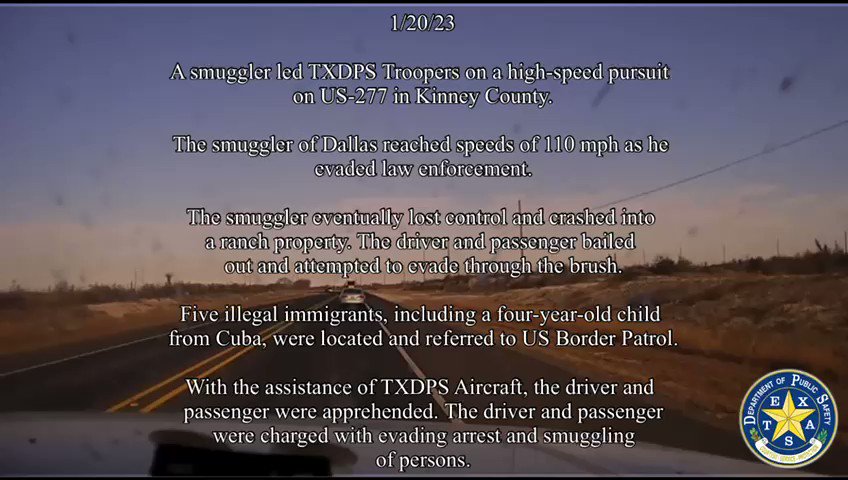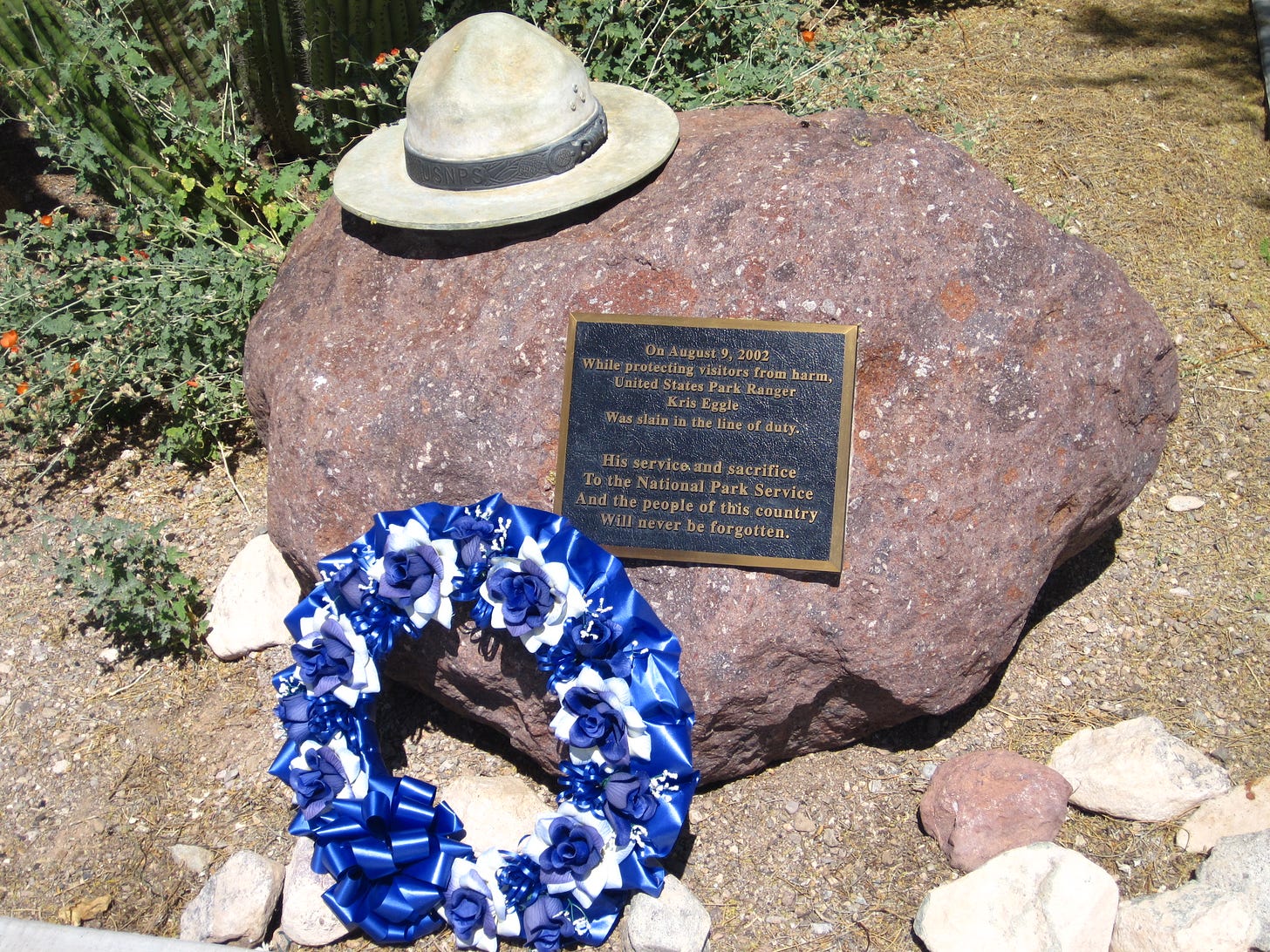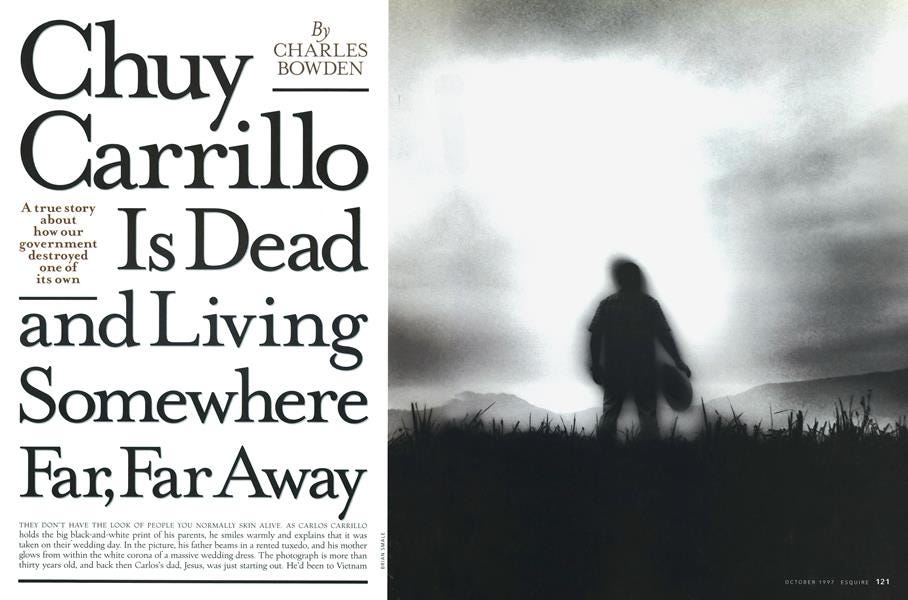More Alerts, More Chases, & Operation Lonestar, What is it good for, anyway?
Good morning friends,
We’re tempted to say it was another quiet weekend in Kinney County— but it actually wasn’t. We’re just getting used to the mayhem. Terrible.
Right before publishing Monday morning, a text alert went out— alerting residents to a police chase that came to an end about 3 miles outside of Brackettville, toward Uvalde. 7 Suspects are said to be on the loose as we write this.
This follows two other text alerts. Both were also overnight affairs, one came early Friday morning, alerting local residents to a bailout behind the local “Stripes” gas station and convenience store.
No arrests were made as far as we know.
Another alert went out just before midnight Sunday morning, alerting residents to a bailout on 131 just south of Highway 90. It took some searching, but 3 female smugglers were caught, and 3 illegal aliens along with them.
Longtime readers may recall, female and underage drivers are being actively recruited by the cartels, because of the difficulty law enforcement has in processing them. They can’t just be quickly shipped to the Del Rio tent city and then on to the lockups at the Briscoe and Segovia Units. That pipeline is for men only. Instead, law enforcement has to find available jail space for women and minors, which there’s a statewide shortage of.
Even if they do find space— deputies and troopers are occupied for a greater amount of time having to sort things out. This creates potential new opportunities for other smugglers to pass through undetected.
Here’s another incident that happened a little earlier in the week, and was caught on video by DPS— showing a high speed chase on 277 coming up from Eagle Pass.
Note the mention of a 4 year old child inside the vehicle, as they got up over 110 mph.

It’s worth noting, the vast majority of high speed pursuits in Kinney County do not warrant a text-alert and actually go unremarked by yours truly, barring any other special circumstances.
Our headline up above asked the question: “Operation Lone Star, what is it good for anyway?”
That’s the question that seems to be raised by a recent piece in the Houston Chronicle, which contrary to initial impressions actually takes a somewhat evenhanded approach. You may run into a paywall trying to read— just refresh the page and click “stop” on your browser, or wait for our excerpt below.
Early in the piece, one is tempted to assume it’s going to be a one-sided affair— taking what some might perceive as unfair shots at an imperfect attempt by the State of Texas to deal with the border crisis without provoking a Constitutional showdown with the Federal Government.
But, by the end of it, it takes a downright balanced tone, maybe even a pro-Operation Lone Star tone— highlighting some areas where OLS seems to be having a positive effect.
It’s the result of reporters trying to be balanced, while presenting the ups and downs of a controversial program.
There’s a whole lot to it— and our excerpt below comes from the very end of the piece.
Skeptics have argued that Operation Lone Star does little to deter migrants from making the journey north, with many fleeing more powerful motivators like violence and persecution in their home countries. Some also claim the effort has actually incentivized migrants to come here or, in other cases, made it easier for them to stay.
There's some evidence, though, that Operation Lone Star could be making an impact. While encounters at the Texas- Mexico border are up compared to when the initiative was launched in March 2021, other states bordering Mexico have seen much steeper increases.
By March 2022, encounters at the Texas- Mexico border had risen by about 9 percent from a year ago — from 109,456 to 119,053, according to data from U.S. Customs and Border Protection. Meanwhile in Arizona, California and New Mexico, the three other states that share a border with Mexico, encounters rose 62 percent.
Texas also saw a 17 percent decline in encounters from July 2021, when state authorities began arresting migrants on state charges, to July of last year.
A recent spike brought Texas back up to 154,606 encounters in December, the most recent monthly data reported by the Biden administration. That is about 41 percent higher than the monthly total when Operation Lone Star began, compared to a 63 percent combined increase in Arizona, California and New Mexico.—Reporters Neena Satija, and Jasper Scherer, The Houston Chronicle
So there you have it, from one of the more critical news organs around: Operation Lone Star, imperfect, but having an effect when compared with Arizona, California, and New Mexico.
There are many folks out there with decent-to-good suggestions for what more the State of Texas could be doing— but the majority invite a showdown with the Federal Government. We’re not exactly Austin insiders here at the Dispatch, but it’s not hard to imagine that the Governor would prefer to avoid something like that, without some signs of support from other large and influential states and/or branches of the Federal Government that do not include the White House.
Consequently, we return once more to the last word from the Governor’s Office to local counties trying to come to grips with the crisis, encouraging them to “Combine their resources and coordinate their activities to protect their own residents.”
If local counties all start to gang up, executing memorandums of understanding, and forming law-enforcement task forces, there won’t be a whole heck of a lot the Federal Government and others will be able to say or do about it. It’s hard to imagine a more muscular, definitive statement to all and sundry, either, than local governments taking it upon themselves to define what will and will not fly.
As always, the price tag associated with all of this will be the main stumbling block— both for local governments and the State of Texas, which still seems to be hoping for some kind of border enforcement payday from the Republican-led U.S. House of Representatives.
Earlier this week, we came across an article about the Border Crisis in Arizona by a man named Allen Wall.
We don’t know the man. He seems to publish essays on a conservative-leaning blog called the Borderhawk Blog. What jumped out at us while reading a recent essay by him, was the story of a U.S. Park Ranger, named Kris Eggle who was murdered by cartel traffickers 20 years ago.
Eggle was a high school valedictorian. An Eagle Scout. And about 28 years old when he was murdered. A plaque and small memorial to the Park Ranger is inscribed with the words “His service and sacrifice to the National Park Service and the people of this country will never be forgotten.”
Sadly. “We,” as a people seem to forget such matters all the time and all too easily. We include ourselves in this, here at the Dispatch.
That said, we personally feel there may be no more derelict phrase in the USA right now than “We will never forget.” Just look at what’s happening along the border— for things to be in such an absolute state, we’ve obviously forgotten a whole lot.
It is an epidemic. The flaccid weakness betokened by this kind of empirically easy-to-forget sentimentality is everywhere. And once you start to see it, it’s hard to unsee it. An old professor used to love to tell us, “You can never go back to being ignorant again.”
Barring brain damage, he was right.
A small update to our last newsletter, about that horrible crash on the bridge between La Pryor and Uvalde. We’ve been told there were actually 6 illegals that went off the bridge. But only 2 were pronounced dead at the scene. The other 4 were taken to the hospital. There’s been no briefing about the extent of the injuries, but broken bones and other trauma are probably just the very beginning of what will be a lifetime of medical difficulty for those who survive any length.
We’re still trying to find a way to put a pin in this one— a good anecdote or piece of history to sum up or at least accompany all of what we’ve been thinking and feeling the last several weeks.
Increasingly, our thoughts turn to the story of a former undercover Border Patrol Agent from the El Paso area, who more than 20 years ago found himself on the outs— suspected of being crooked because of possibly jealous agents in the DEA, and targeted by the cartels who wanted to kidnap him, take him across, and skin him alive.
His name is Chuy Carrillo. And, at one time, his undercover alter-ego “Don Chuy” was the terror of drug pushers and undercover DEA agents alike. Imagine a hardcore Norteño-styled man, dressed as a successful rancher. Black leather vest. Jeans. Boots. White shirt. Black hat. Big black mustache. Eat your heart out, Pancho Villa.
Don Chuy was the guy many in El Paso thought was the mover and doer for narcotics. If you called him wanting to move some freight, you had to be ready to come up with large amounts— he wasn’t going to talk to you about piddly stuff.
He was supposed to be a wizard with a cellphone, capturing a kind of brusque, almost rude manner that forced those calling him to quickly establish their bonafides as criminals. Strange callers had to qualify themselves to Don Chuy— fighting their way past a blizzard of words including “Pendejo” and others, before he’d be ready to make a deal. By the time they did, usually, they were under his spell, rarely questioning his status.
Author Charles Bowden penned perhaps the most definitive treatment of Don Chuy’s exploits and how he was subsequently hung out to dry in the pages of Esquire magazine, back in 1997. A copy of the text is available on scribdb, if you have a membership. Highly recommend. You can sign up for free and read it right now. We read it for the first time while sitting in a dentist’s office many years ago. It’s never left us. You can also sign up for Esquire Classic online, but we don’t imagine too many people do.
Read it for the eye-opening account of his encounters with DEA and how they apparently embarrassed members of the agency.
An updated, but less thrilling account is also available here, by El Paso Times reporter Daniel Borunda. It’s no shade on Borunda— he does a fine job. Bowden’s just one of those beasts of a wordsmith, who sadly is dead now, passing away in 2014. It might’ve been good to read his thoughts on the present crisis.
We’ve shared the tale with sources in DHS, asking if it’s just a little too far beyond the realm of possibility— the idea that a petty rivalry between agencies could lead to a patriotic and effective agent like Chuy Carrillo getting maligned and nearly murdered.
Sadly, we were told that it’s not.
Luckily for Chuy Carrillo, there’s no plaque or statue in his honor anywhere. No place for well-meaning but flaccid sentiments like “We will never forget.”
He lived.
Have a great morning— we’ll probably be back later this week at least once, maybe twice.
The weather guessers say the cold weather’s going to continue— good. Keep it coming. We have many sweaters to wear.
As always, this newsletter is an independent production, kept as distant as possible from our day job at Kinney County. Its genesis predates our hiring at the County, and no one should mistake it for an official communication. Indeed, any errors, mistakes, or other misdeeds are entirely our own.
See you soon.





